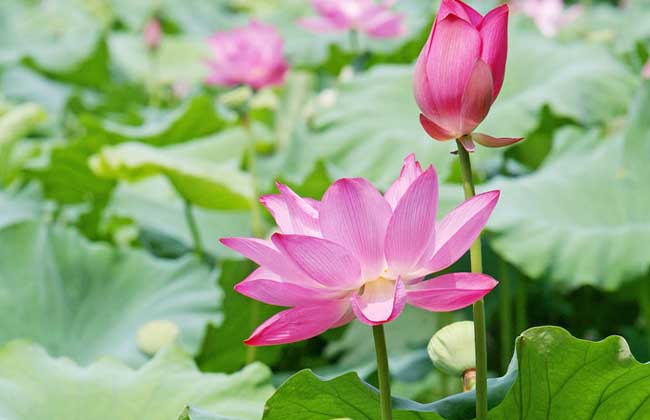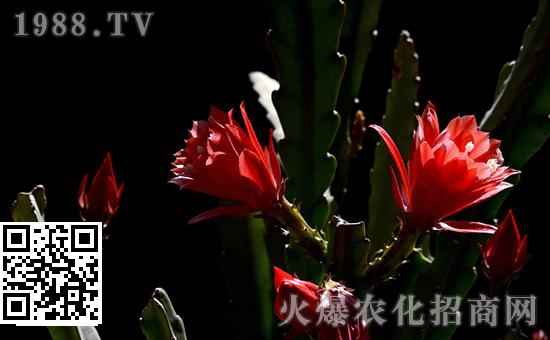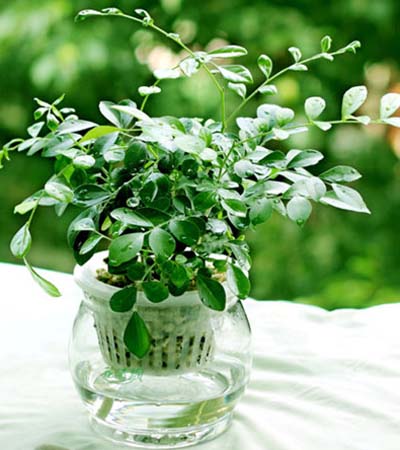Seed sowing technique of potted lotus
Seed sowing techniques of potted lotus:
The lotus seeds mature from July to August and can be sown with picking or sowing when the weather turns warm in April of the following year.
2. As the shell of the lotus seed is hard, the thick head of the lotus seed with microholes should be cut before sowing, but care should be taken not to hurt the lotus flesh.
3. Soak the lotus seeds in 20-30 ℃ warm water, the water depth is about 8 cm, change the water once a day, it can germinate in about 5 days, and pot in the open air when 2-3 leaves are grown.

Propagation techniques of potted lotus
1. Seed propagation: the concave end of the seed should be worn out on the rough ground from May to June every year, and then soaked and raised, the water should be changed frequently, the water should be kept clean, it will sprout in a week or so, and it will take root and transplant after two weeks of budding, one plant in each pot, the water layer should be shallow, and the lotus leaves should not be submerged in water.
2. Split lotus root propagation: the best time to turn potted lotus root is from mid-March to mid-April. Before planting, the basin mud should be mixed into a paste. When planting, the top of the lotus root is inserted at an oblique angle of 20 degrees along the edge of the basin, and the bowl lotus is about 5 cm deep. The large lotus is about 10 cm deep, the head is low and the tail is high, and the tail is half warped up to keep the end of the lotus root from entering water. After planting, put the pot in the sun to make the surface soil crack, so that the lotus root is completely bonded with the soil, then add a small amount of water, wait for the bud to grow, gradually deepen the water level, and finally maintain the water layer of 3-5 cm.
Planting methods of potted lotus
1. Variety selection: potted lotus should choose ornamental strains suitable for potted plants, such as Buddha seat, Chongtai, Bijiangxue, Dabilian, Yizhang Qing, Jiaolong San Variety, Shouxing Peach, West Lake and so on.
2, flowerpot selection: potted lotus usually uses shallow lotus pots, bucket pots, or shallow pots with a caliber of more than 60 cm. Use the old basin and wash it clean inside and out. If you use a family water tank, because the height is on the high side, you can spread masonry at the bottom of the tank to make it shallow, the cylinder is too deep, and there are more frequent leaves and less flowers.
3. Cultivation soil: the cultivation soil of potted lotus usually uses pond mud or paddy field mud rich in humus. First, the mud is mashed and screened. If there are impurities, gravel, etc., it needs to be picked out to make the mud muddy. Put it in a basin with a thickness of 10-15 cm. At the same time, any kind of sun-dried chicken and duck dung, dried human manure, bean cake, vegetables, chicken feathers, hair, grass and so on can be used as base fertilizer.
4. planting time: potted lotus can be planted before and after Ching Ming Festival, that is, it is best to plant in late March, it is easy to rot the lotus root node prematurely, and the plant blossoms poorly, even if it blossoms, the flowers will be under the leaves, affecting the ornamental value.
Culture and management of potted lotus
1. Soil quality management: Lotus requires fertile clay loam rich in humus, which affects the elongation of lotus root and the expansion of lotus root. Easy soil is vulnerable to wind damage and hinders the development of root system, which is not conducive to the growth of lotus. The soil is usually lake and pond mud, and it can also be mixed with 4 parts of garden soil, 3 parts of loess and 3 parts of sandy soil. PH6.5-7.5 is the best soil.
2, light management: the lotus likes strong light and receives 7-8 hours of light every day, which can make its buds more, flowers bloom continuously, do not cultivate in the shade, and indoor viewing can not exceed the same day when seeing flowers. The lotus in the family pot must be placed on the balcony or in the courtyard and move to a shady place at noon to avoid the scorching sun.
3. Temperature control: Lotus is very strict on temperature, generally 8-10 ℃ begins to sprout, 14 ℃ lotus root begins to elongate, 25-30 ℃ is the most suitable temperature for lotus growth and development, especially in rainy and sunny weather is more conducive to plant growth.
4. Rational fertilization: potted lotus plants usually apply 200-500 grams of chicken manure as base fertilizer according to the size of potted seven. A month after planting, you can put rotten bean cake water or liquid fertilizer based on human feces and urine once, with a concentration of 10%. After standing leaves, topdressing 1-2 times, and applying superphosphoric acid every 7 days.
5, water management: the temperature is high in summer, lotus is easy to lose water, add water 1-2 times a day, keep the water clean, if you find water dirty, change water. Late autumn and early winter, lotus into the dormancy period, do not often add water, only to keep shallow water.
6. pest control: the common lotus pests are aphids on floating leaves or small standing leaves and Spodoptera litura occurred from July to August, which can be sprayed with 1500-2000 times of 50% dimethoate emulsion or 2.5% of fish rattan essence.
How to grow potted lotus culture methods of potted lotus
Lotus has always been a very popular flower plant, in the writings of scholars and poets, there are too many beautiful poems. In the past, lotus flowers were planted in large areas of water, such as ponds and small lakes, but now we can plant them in pots and bring them to our homes. Next, let the editor introduce the cultivation method of potted lotus to you.
Brief introduction of Lotus:
Lotus, also known as lotus, water hibiscus, etc., belongs to the order Nelumbo nucifera, lotus family perennial aquatic herbaceous flowers. The underground stem is long and thick, with long nodes, that is, I often say lotus root, leaf shield round, florescence from June to September. There are many kinds of lotus, which can be divided into two categories: ornamental and edible, lotus all over the body, lotus root and lotus seed can be eaten, lotus seed, rhizome, lotus root node, lotus leaf, flower and seed germ can be used as medicine.
Growth habits of lotus:
Lotus is native to tropical and temperate regions of Asia and is an aquatic plant. It is suitable for calm shallow water, lakes, marshes and ponds where it is relatively stable. The lotus is very sensitive to water loss. The lotus leaves planted in the water tank will wither as long as they are not irrigated for 3 hours in summer. if the water stops for one day, the lotus leaves will scorch and the buds will wither. The lotus also likes light very much and needs full light during its growth period. The lotus is extremely intolerant to shade and will show a strong phototaxis when it grows in the semi-shade.
How to grow potted lotus:
Lotus likes warmth and sunshine, avoid yin and bitter water, but like stable still water. Avoid dry, avoid deep water, hate the flowing water with great disparity in fluctuation. Suitable for humus-rich and slightly sticky soil, do not like loose sandy soil. Afraid of the cold, branches and leaves withered in autumn and winter, but the underground stem (lotus root) can survive the winter without freezing water. Generally 8-10 ℃ germination, 14 ℃ lotus root growth, high temperature flowering, 25 ℃ growth of new lotus root.
Culture methods of potted lotus:
1. Soil quality: Lotus requires fertile clay loam rich in humus. Excessive clayey soil affects the elongation of lotus root and the expansion of lotus root; easy soil is vulnerable to wind damage and hinders root development, which is not conducive to the growth of lotus. The soil is usually lake and pond mud, and it can also be mixed with 4 parts of garden soil, 3 parts of loess and 3 parts of sand. PH6.5~7.5 is the best soil.
2. Lighting: the lotus likes strong light and receives 7-8 hours of light every day, which can make its buds more, flowers bloom continuously, do not cultivate in shade, and indoor viewing can not exceed the same day when seeing flowers. The lotus is raised in the family pot. Be sure to put it on the balcony or in the courtyard and move to a shady place at noon to avoid the scorching sun.
3. Temperature: the lotus is very strict on the degree of depression, generally 8: 10 ℃ begins to sprout, 14 ℃ lotus root begins to elongate, 25: 30 ℃ is the most suitable temperature for lotus growth and development, especially in rainy and sunny weather is more conducive to plant growth.
4. Fertilization: the lotus is cultivated in the pot, and the chicken manure in the range of 200 to 500g is applied as the base fertilizer according to the size of the pot. the lotus cultivated with this fertilizer is better than pig manure, cow manure and human manure as the base fertilizer. One month after planting, you can put rotten bean cake water or human feces and urine-based liquid fertilizer at a concentration of 10%. After the standing leaves were produced, they were topdressing for 1 or 2 times, and superphosphoric acid was applied every 7 days during flowering.
5. Moisture: the lotus is easy to lose water when the temperature is high in summer. Therefore, the pot should add water once every two days, and the pot should add water once or twice a day, which should be roughly the same as the water temperature in the pot, and keep the water clean. If the water is found to be dirty, change the water. At the end of autumn and the beginning of winter, the lotus enters the dormant period, it is not necessary to add water frequently, only shallow water can be kept in the cylinder basin.
6. Diseases and insect pests: the common lotus pests are aphids on floating leaves or small standing leaves and Spodoptera litura from July to August. It can be sprayed with 50% dimethoate emulsion 1500-2000 times or 2.5% fish rattan essence 500 times.
The above is the specific introduction of the cultivation methods of potted lotus, through the above content, we should know how to grow potted lotus. I hope the above content will be helpful to you to cultivate lotus, and I also hope that you can grow more beautiful lotus.
- Prev

How do lotuses reproduce?
How to reproduce lotus: 1. Seed reproduction (1) Soak seeds in August to September to collect fully mature lotus seeds for storage, and sow them from mid-April to June. Before sowing, cut a small opening at one end of the lotus seed recess to expose the seed coat. As long as the embryo is not damaged, it will germinate in 3~7 days (if sowing in July ~ August).
- Next

How to choose hydroponic flowers and plants?
How to choose hydroponic flowers and plants? Hydroponic flowers are not aquatic flowers, it is a soilless cultivation method of flowers, flowers are cultivated in soilless nutrient solution, plants do not have aquatic structure, in the process of cultivation, water should be often changed to replenish oxygen or increase oxygenation equipment.
Related
- Fuxing push coffee new agricultural production and marketing class: lack of small-scale processing plants
- Jujube rice field leisure farm deep ploughing Yilan for five years to create a space for organic food and play
- Nongyu Farm-A trial of organic papaya for brave women with advanced technology
- Four points for attention in the prevention and control of diseases and insect pests of edible fungi
- How to add nutrient solution to Edible Fungi
- Is there any good way to control edible fungus mites?
- Open Inoculation Technology of Edible Fungi
- Is there any clever way to use fertilizer for edible fungus in winter?
- What agents are used to kill the pathogens of edible fungi in the mushroom shed?
- Rapid drying of Edible Fungi

